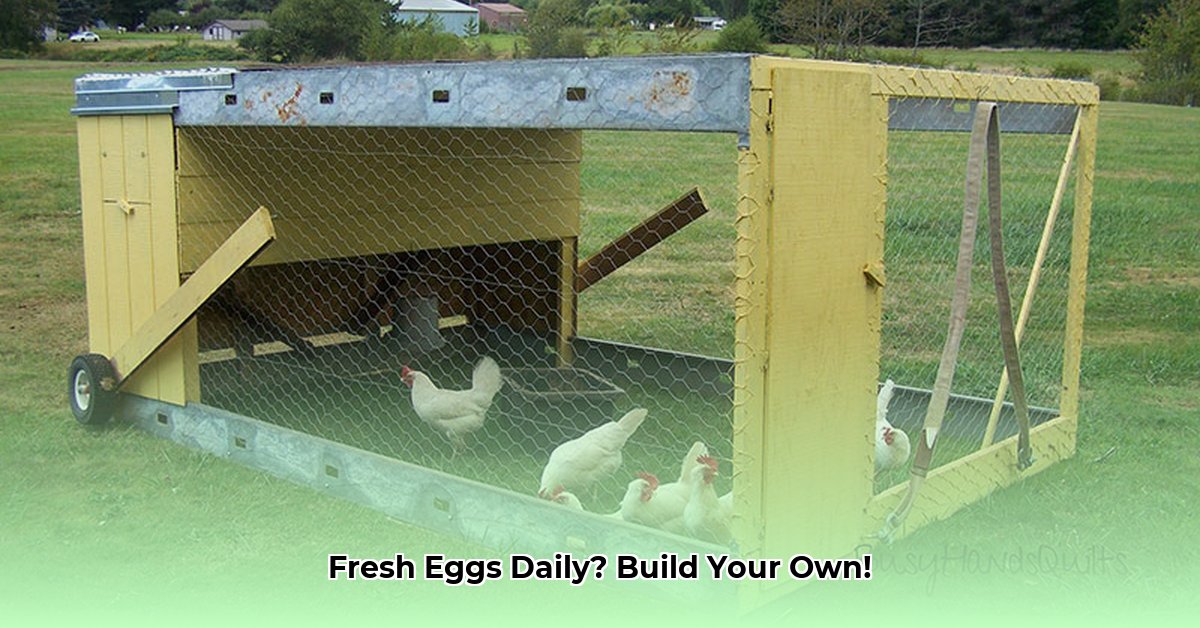
Building a chicken tractor is a fantastic way to enjoy fresh, farm-fresh eggs while promoting sustainable agriculture and improving animal welfare. This guide provides a step-by-step approach to building your own, complete with design considerations, construction instructions, pasture management tips, and essential biosecurity measures. For a sample plan, check out this 6-hen tractor design. Let's get started!
Design Considerations: Choosing the Perfect Chicken Tractor
Before you begin building, carefully consider your specific needs and resources. Many chicken tractor images online offer design inspiration. Key factors to consider include:
- Size: A good starting point is 4 square feet per hen, but this can vary depending on breed and pasture size. Larger tractors mean less stress for your flock. What's the ideal size for your flock and pasture?
- Materials: Common choices include treated lumber (for weather resistance), metal (for durability), or repurposed materials. Each has pros and cons concerning cost, durability, and ease of construction. What materials are most readily available and affordable for you?
- Mobility: Wheels or skids are essential for pasture rotation. Consider the weight capacity and ease of movement when selecting these components. How easily will your selected mobility solution work on your terrain?
- Flooring: Wire mesh is preferred for ease of cleaning and manure management, allowing natural fertilization. Solid flooring needs more frequent cleaning to prevent ammonia buildup. Which approach best suits your needs and cleaning preferences?
- Nesting Boxes: Provide a comfortable, enclosed area for egg-laying. Consider the number of hens and design accordingly. How many nesting boxes will your hens need?
- Predator Protection: Strong wire mesh, a secure roof, and possibly buried hardware cloth are crucial for protecting your flock. What are the primary predators in your area, and how will you address them in your design?
- Climate: Adapt your design to local weather conditions. Insulation might be necessary in colder climates, while good ventilation is crucial in hotter areas. How will your design account for seasonal changes in your climate?
Remember, a well-thought-out design is the foundation of a successful chicken tractor.
Building Your Chicken Tractor: A Step-by-Step Guide
This project requires basic carpentry skills. Many online resources, including videos, can assist you throughout the construction process. Let's break down the key steps:
- Gather Supplies: Create a detailed list of all necessary materials based on your design. Accurate measurements are crucial to avoid material waste.
- Construct the Frame: Build a sturdy rectangular frame using your chosen lumber. Ensure that the frame is square and corners are secure. Precise cuts and strong joints are essential for a durable structure.
- Attach the Wheels/Skids: Securely attach your chosen mobility system to the frame. Reinforce the frame around the wheels/skids to ensure sufficient weight capacity.
- Install the Wire Mesh: Attach the wire mesh to the frame, ensuring a secure fit to prevent escapes and predator entry. Overlap edges and use strong fasteners.
- Add Nesting Boxes: Create a protected area within the tractor for egg-laying. Use soft bedding such as straw.
- Construct and Attach the Roof: A roof protects your chickens from weather and predators. Ensure it is securely attached and provides adequate protection.
- Final Touches & Adjustments: Complete any remaining details, such as reinforcing weak points or adding additional predator proofing.
Building your chicken tractor is a learning experience. Don't be afraid to adapt your design as you go.
Pasture Management and Rotation: Maximizing Pasture Health
Rotating your chicken tractor is crucial for preventing overgrazing and maintaining soil health. This process provides:
- Natural Fertilization: Chicken manure acts as a natural fertilizer.
- Pest Control: Chickens help control insect populations.
- Weed Suppression: Chickens help suppress weed growth.
A typical rotation schedule involves moving the tractor every 2-3 days, depending on flock size, pasture size, and vegetation regrowth. Monitor pasture conditions closely. Signs of overgrazing necessitate more frequent moves. "Effective pasture rotation is about mimicking natural processes, allowing land to regenerate," says Dr. Sarah Miller, Professor of Sustainable Agriculture at Cornell University.
Animal Welfare and Biosecurity: Keeping Your Flock Healthy
Prioritizing your chickens' well-being is key to successful poultry keeping. Essential practices include:
- Feeding: Provide a balanced diet, supplemented with pasture grazing.
- Watering: Ensure constant access to fresh, clean water.
- Disease Prevention: Regularly monitor your flock for any signs of illness. Maintain good hygiene practices within the tractor and surrounding area.
- Predator Protection: Maintain a vigilant approach to predator control. Regularly inspect fencing and implement preventative measures.
Dr. David K. Jones, a poultry specialist at the University of California, Davis, emphasizes that, "Proactive biosecurity measures are essential for preventing disease outbreaks and maintaining the health of your flock."
Regulatory Considerations: Checking Local Ordinances
Before starting your project, check local ordinances regarding backyard chickens. Regulations vary widely. You might need permits or face restrictions on flock sizes or coop designs. Contact your local agricultural office or municipality for the most up-to-date information.
Enjoy Your Fresh Eggs!
Building your own chicken tractor is a rewarding experience! You'll enjoy fresh, healthy eggs and the satisfaction of raising your chickens sustainably. Remember that ongoing observation and adjustment are key to successful chicken keeping. Happy farming!